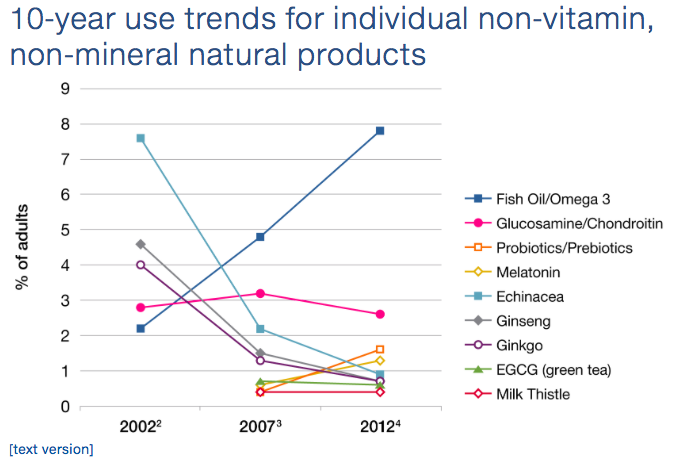NIH survey of supplement use shows strong support for omega-3s, wavering commitment to joint ingredients and echinacea

Winners
The survey showed that “fish oil/omega-3/EPA, DHA fatty acids” was the most popular natural product used by American adults in 2012. According to NIH, 18.3 million Americans used products containing the ingredient, or 7.8% of all US adults. About 664,000 children used the products in that year, or 1.1% of the total population. The use trend for adults was up from a little more than 2% in 2002.
In terms of sales, which were calculated on a 2003-20011 time frame, omega-3s were the big winner, too; marketers sold about $195 million of the products in 2003, rising to about $700 million in 2007 and nearing $2 billion in 2011. Another big winner in terms of sales was probiotics; the ingredients were not included in the 2002 survey but in 2007 they accounted for about $390 million in sales, rising to about $775 million in 2011.
Melatonin use rose, too; rising from about 0.5% of the population having reported using the products in 2007 to about 1.75% in 2012. In sales terms the numbers went from about $100 million to $200 million.
Losers
Leading the list of those products that showed use declines is echinacea. This botanical, as previously mentioned, showed a continued steep drop. In 2002, NIH assessed the use level of products containing echinacea at about 7.7% of US adults; by 2012 this had dropped to under 1%. Surprisingly, given the continued trend of an aging population, glucosamine and chondroitin showed a decline after rising in the period between 2002 and 2007. In 2007, a little more than 3% of US adults used these ingredients according to the survey; by 2012 this figure had dropped to about 2.7%. In terms of sales, the two venerable joint health ingredients peaked at about $810 million in 2007 and slid to about $750 million in 2011.
Accounting for the trends
So what accounts for the trends seen in the report? For Corey Hilmas MD, PhD, senior vice president of scientific and regulatory affairs at the Natural Products Association, the research backing for the ingredients, and especially how those results are reported in the media, has a lot to do with it. And the public and mainstream media’s memory is short, so it’s a case of what have you done for me lately, he said.
“The trends we see in the NIH survey reflect the evidence for each ingredient over time,” Hilmas told NutraIngredients-USA. “It doesn’t necessarily reflect the overall state of science for each ingredient. For some of the more established ingredients, there is almost too much historic evidence.”
Hilmas said changes in the media landscape, and how younger news consumers get and use their information, has driven some of the market shifts seen in the NIH survey. He said this may be one of the dynamics driving the decline of gluscosamine and chondroitin, ingredients that common sense might dictate should be enjoying wider success with the greater demand for healthy aging products given the nation’s long-term demographic trends.
“Gen Yers tend to get their news faster, so the latest study results matter. TV news shows spend more time on health segments now. The information is at their fingertips, and more consumers of this generation are blogging about the latest health results.”
Hilmas said in the period before the 2007 survey, some promising results had come out about the effect of glucosamine and chondroitin on osteoarthritis discomfort. Then the skies started to cloud for these ingredients.
“Prior to 2005 there was that excitement and buzz for these ingredients’ effects on osteoarthritis. Then in 2005 a large meta analysis threw out some of those older studies and ended up showing no difference from placebo. There was a second review in 2005 that was more positive and slowed the bleeding a bit.
“Then in 2007 NIH came out with its GAIT study (Glucosamine/Chondroitin Arthritis Intervention Trial). That study suggested that even their positive control (a pharmaceutical) showed that it wasn’t superior to placebo,” Hilmas said.
“Were all of those studies done well? A lot of people don’t know the difference betwenn a meta analysis, a retrospective study or a prospective study. A lot of the effect of these studies lies in the messaging about them,” he said.
Shift in overall focus
For Judy Blatman, senior vice president of communications for the Council for Responsible Nutrition, the key takeaway from the most recent survey is not the market shifts, which will tend to occur over time for one ingredient or another. Rather, it’s the way the survey was named and constructed that demonstrates the increasing traction that differnt health care modalities, among them the use of dietary supplments, are gaining traction in society. The survey assessed not only dietary supplement use, but also the use of health care modalities including chiropractic or osteopathic manipulation, massage, mediation and yoga.
“The survey is titled ‘The Use of Complementary Health Approaches in the US.’ That is a major change because it says that these approaches aren’t ‘alternative,’ rather they are complementary pieces of the health care puzzle. That is really an important thing because it shows the government is recognizing that that is what is happening in this country. There is a shift among consumers away from sick care toward prevention,” she said.
“Consumers come in and out of product categories. But there is this overall embracing of these kinds of products and these kinds of practices. The overall trend is up,” Blatman said.
To see the full survey, click here.
















